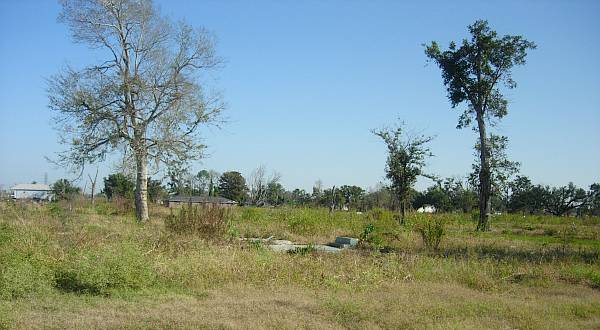
Pages in this Folder:

Related Folders:
See also Department Site Map
Publications:
Market-related videos
Comments?
For the basics, see
- Website & Privacy Policies
- How To Get Involved
- The Role of the Park
Search options:
Department Site Map
Custodians:
posted November 8, 2006
Adventures in the Life of a Market Manager: New Orleans
This year I have been working with Foodshare on a project they received funding for from Project for Public Spaces, based in New York. This project supports networks of farmers' markets in diverse regions and circumstances. The Toronto project, still in the fledgling stages, is aimed at building effective ways to get produce to communities that don't have good fresh food access, strengthening links between existing and new markets around the city, and supporting local agriculture through access to healthy city markets.
A requirement of the project is attendance at convening meetings, when participants from the nine groups that received grants learn together, and share ideas and information. I have gained a lot from meeting these people, who have a great combined wealth of experience. Ideas both large and small will contribute to our market and, I hope, to others as well. For now, though, I'd like to share some of my impressions of the place the meetings were held, as a first visit to New Orleans is an intense experience these days.

Angel in the French Quarter
We stayed in the French Quarter, where the population has dropped from about 25,000 to 5,000 steady inhabitants, but where streets are charming and, except for the many for sale/for rent signs, life looks unchanged. The shuttered houses and interior courtyards have always hidden a lot from the outsider. Of course, we were busy in meetings, too, so it was hard to get any sense initially of what has taken place from this vantage point. The newspaper told depressing stories of corruption and crime. Some residents spoke of wanting to stay "one more year" and then leave the area altogether. But we began to find that there are people who call New Orleans home with a passion that one rarely encounters in "ordinary" life. Some were born there, but interestingly, we met quite a few who had chosen to live in the city only 5 years or so ago, but now have firm plans to stay, even if friends have scattered across the country.
We were very fortunate in getting to spend time with Richard McCarthey, whom one might call the charismatic leader of New Orleans markets. I can't possibly say things as well as he did, so this small summary is full of my best attempts to note and remember his words. While he did reveal a glimpse of his own sorrow and stress, he spoke mainly of opportunities.
He told us some of the pre-Katrina background of creating markets in New Orleans, which had no true farmers' markets left until they were re-created in the 1990s. It took ten months of searching to find enough farmers who would come into the city to start the first one. They named it the New Orleans Greenmarket, and were soon threatened with a lawsuit from the organizers of Greenmarket in New York City, who claimed ownership of that name. In a great example of turning adversity into something positive, they shared this information with the community, which initially took offense, then began to enjoy countering with humour about wanting the "New" back from New York since New Orleans had it first, then contributed 1,000 entries to a renaming contest for a market that had become theirs.
Ten years of success in building markets has had to be put firmly on the shelf. Everything now is about re-invention, not just rebuilding. Richard said that Katrina saved the city from 30 years of slow steady death in one week, and in this city where change is rarely embraced, the storm could be seen as an anarchist's dream come true. Getting people involved at a neighbourhood level represents a huge challenge, though, as the tradition is based on "imperial regimes that do things", not town-hall involvement. Right now there are community meetings with long-distance call-ins as well as in-the-room participants because so many citizens are based elsewhere. With every month that passes, fewer people now living "temporarily" away plan to come back.
The importance of food here is huge: "it's a city where people talk about what they like to eat, not what they do for a living, with a low standard of living, but a high quality of life". Although the population base, at 40% pre-storm levels, isn't really large enough to sustain large, thriving markets, many people begged for the markets to reopen quickly. The market organizers used their website as a bulletin board to post updates about where farmers/fishers/staff were, and to find out where the approximately 2,000 customers on their mailing lists were living, who had a stove, and where markets should now be located. When communication became so critical, it didn't take long for all the market farmers to get laptops, and funds were raised to pay farmer "deputies", who communicated with others in their regions. The first markets reopened last November, and while the "flagship" one we visited, Crescent City Farmers Market, couldn't yet be described as bustling, their slogan is "it's the happiest place in New Orleans".
The enthusiastic turnout for the Mirliton Festival, a quirky neighbourhood event celebrating the chayote, or vegetable pear, also gave us an idea of the appetite for fun in what used to be called "the city that care forgot". We met a vegan home chef there who said that monthly vegan potlucks are much bigger than before the storm as people want so much to get together.
The local Slow Food movement, led by another magnetic personality, Poppy Tooker, is very strong. Last Thursday night, Poppy cooked a very, very delicious meal for us and other groups of visitors as she told story after story. When the satsumas, a much-loved local specialty, came in at this time last year, the growers had lost their customers. Poppy put the word out to Slow Food lovers across the country, and set up a mail-order honour-based payment system so the satsumas could be shipped all over. It was a big success, and this year, her dream is to see Louisiana shrimp, in 15 pound boxes, under every Christmas tree. She was just off the plane from Terra Madre, where the shrimpers had been a sensation in their white rubber boots and Mardi Gras beads. "White Boot Brigades" have brought roving shrimp markets to many locations, and the industry is being reinvented, with deliveries to chefs and pickup of used oil for biodiesel as part of the picture.

This was the Lower Ninth Ward
These kinds of efforts are exciting, but the mind-altering shock of seeing the worst affected areas is something I haven't fully processed yet. The day before we came home, we were escorted through the lower ninth ward and other areas greatly altered by flooding. I took some photographs that look like views down a country road, with lines of (remarkably) still-standing trees and green growth all around, but if you look closely, you can see small front stoops in the grass, almost all that remains of rows and rows of homes in a once densely populated neighbourhood that has been relocated to a landfill site. Here and there totally ruined, twisted wrecks have been left behind for reasons that are unclear. A short section of useless levee provides the backdrop. Down the road are areas where some houses might be salvaged, but toxic mold, legal complexity and other issues slow decisions. To qualify for funding, new flood regulations require houses to be elevated much higher than before. Sadly, this means that many elderly former residents of the area may not be able to live in them.

House Search markings
The houses are marked with large spray-painted X's and symbols. We all wanted to know what these meant. A date, most often 9-11, an abbreviation for the regiment or volunteer group that checked the house for survivors, and a blank or a number on the bottom to indicate whether bodies were found. Sometimes SPCA was sprayed on the house to indicate that an animal needed rescue. In areas where people were moving back, very few of these markers had been painted over, and we wondered about that too.
Our bus driver, a friendly man with one of those wonderful accents you can't help trying to duplicate, was full of stories, and eager to tell them. Many people are, despite "Katrina fatigue", and the ongoing stresses they face. The bus company also operates swamp tours by air boat, so drivers like ours, whose own home was not destroyed, returned to the city just two days after the storm to help with rescue efforts. He described launching an airboat in two feet of water on the highway and heading into areas where the depth of floodwaters reached nine feet. Looking down in the relatively clear water, he could see pickup trucks parked below. The police gave him the assignment of assisting in the rescue of prisoners who had been trapped for two days with no information in their cells. Yes, water was coming in. This isn't my story to tell.

Habitat for Humanity Musicians' Village
We stopped beside the Musicians' Village, a Habitat for Humanity project that has seen many youth brigades and other volunteers arrive this year to build small but pleasing houses, brightly painted. It's a much more appealing destination than the FEMA trailer parks that are home to many people waiting for an alternative. In a bittersweet example of people's resilience, there was an article in the weekend paper featuring the winners of the trailer gardens contest. One woman described transplanting white vinca and other "volunteers" that popped up here and there to create a little garden in her empty yard; others built squirrel feeders or salvaged bits of statuary to decorate tiny outdoor spaces.
When we had some free time near the end of our stay, Jennifer Reynolds(from the Foodshare project) arranged for us to meet up with friends who have recently returned to NOLA after a year in exile. He's a doctor, working to provide health care for those who need it most, and she's an artist whose animation works show her recent experiences. Remarkably positive people, they are among the fortunate in that they were insured. The mortgage on their charming little house has been paid, but they lost virtually all their belongings and their house is completely gutted, in a neighbourhood with hardly any inhabitants. They've rented temporary quarters in another, partially occupied area, and made a warm home for their small son while they sort out their options. I don't really know yet how to feel about the New Orleans of this moment. I just know thoughts of these people, all the people we met, will colour the news reports as the future unfolds.
Anne Freeman, November 2006
January 10, 2007
A sad addition to the story
Today, I need to write a sad addition to this story. The people I described in the paragraph above are the same people whose sweet faces appeared on the front page of last Saturday's Globe and Mail with the horrifying story of the home invasion that left Helen Hill dead and Paul Gailiunas shot multiple times. Helen's funeral is today. In California, Halifax, South Carolina and other cities, friends are in mourning, gathering to share food and play music in honour of these kind, gentle people who were so committed to making New Orleans a better place. As the reverberations travel, I hope somehow their friends and fellow citizens in NOLA will find courage.
- Anne





 Printer friendly version
Printer friendly version